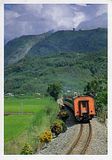
 Kota Bharu (Jawi:كوت بهارو), a city in Malaysia, is the state capital and Royal City of Kelantan. It is also the name of the territory (jajahan) in which Kota Bharu City is situated. The name means 'new city' or 'new castle/fort' in Malay. Kota Bharu is situated in the northeastern part of Peninsular Malaysia, and lies near the mouth of the Kelantan River. In 2005, it had an estimated population of 425.294, making it one of the largest towns on the east coast of Peninsular Malaysia. This northeastern Malaysian city is close to the Thai border, and is home to many mosques. Also of interest are various museums and the unique architecture of the old royal palace (still occupied by the sultan and sultanah and off-limits to visitors but viewable from outside) and former royal buildings (which can be visited) in the center of town.
Kota Bharu (Jawi:كوت بهارو), a city in Malaysia, is the state capital and Royal City of Kelantan. It is also the name of the territory (jajahan) in which Kota Bharu City is situated. The name means 'new city' or 'new castle/fort' in Malay. Kota Bharu is situated in the northeastern part of Peninsular Malaysia, and lies near the mouth of the Kelantan River. In 2005, it had an estimated population of 425.294, making it one of the largest towns on the east coast of Peninsular Malaysia. This northeastern Malaysian city is close to the Thai border, and is home to many mosques. Also of interest are various museums and the unique architecture of the old royal palace (still occupied by the sultan and sultanah and off-limits to visitors but viewable from outside) and former royal buildings (which can be visited) in the center of town.The City is served by Keretapi Tanah Melayu's East Coast Line at the nearby Wakaf Bharu Station, in the town of Wakaf Bharu across the Kelantan River. Kota Bharu was established by Sultan Muhammad II of Kelantan in 1844 as Kelantan's capital. Pantai Sabak, about 10 km from Kota Bharu, was the initial landing point of the Japanese invasion forces on 8 December 1941 in their Malayan campaign when they successfully engaged the British in jungle warfare and ultimately captured Singapore.































No comments:
Post a Comment